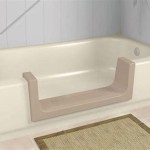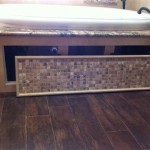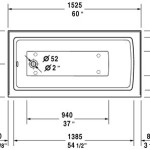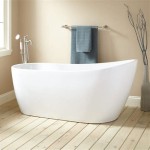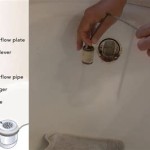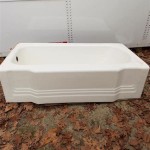Unclogging Bathtub Drains with a Drain Snake
A clogged bathtub drain is a common household problem that can disrupt daily routines and potentially lead to more serious plumbing issues. The accumulation of hair, soap scum, and other debris often restricts water flow, resulting in standing water in the tub. While chemical drain cleaners offer a seemingly quick solution, they can be harsh on pipes and pose environmental risks. A drain snake, also known as a plumbing snake or an auger, provides a mechanical alternative for clearing obstructions in bathtub drains. This article provides a comprehensive overview of how to effectively use a drain snake to unclog a bathtub drain.
Understanding the anatomy of a standard bathtub drain is crucial before attempting to use a drain snake. Most bathtubs have a drain opening at the bottom, often covered by a stopper or strainer. The drain then connects to a P-trap, a curved section of pipe designed to trap debris and prevent sewer gases from entering the home. Beyond the P-trap, the drain line connects to the main plumbing system. Clogs typically occur within the drain opening, the P-trap, or the initial section of the drain line. Identifying the location of the clog is not always possible without specialized equipment, but understanding the general plumbing layout helps in targeting the snaking process.
Different types of drain snakes are available, varying in length, diameter, and mechanism. A basic hand-cranked drain snake is sufficient for most bathtub clogs. These snakes usually consist of a flexible metal cable housed within a drum, with a handle for rotating the cable. More advanced power augers are available, but may be unnecessary for common bathtub blockages. Small, specialized drain snakes are also available for accessing drains with smaller openings or complex curves.
Preparing to Use a Drain Snake
Before inserting the drain snake, certain preparatory steps are necessary to protect the bathtub and ensure effective unclogging. First, the bathtub should be cleared of any standing water. Removing the drain stopper or strainer is essential to provide access to the drain opening. Many stoppers can be removed by simply lifting and twisting, while others may require unscrewing a visible screw or releasing a hidden mechanism. If the stopper is difficult to remove, consulting the manufacturer's instructions or seeking assistance from a qualified plumber is advisable. Examine the removed stopper and clean off any visible debris, such as hair or soap scum. This prevents re-introduction of material into the drain.
Protecting the bathtub's surface from scratches is a priority. The metal cable of the drain snake can easily scratch the porcelain or acrylic finish of the tub. Placing a towel or rag around the drain opening can provide a protective barrier. This also helps to stabilize the snake as it is inserted and rotated. Additionally, wearing gloves is recommended to protect hands from dirt and potential contaminants within the drain. Consider wearing eye protection to prevent splashes from entering the eyes during the unclogging process.
Proper lighting is beneficial for visually inspecting the drain and ensuring the snake is properly positioned. A flashlight or headlamp can illuminate the drain opening and allow for better control of the snake's insertion. If the drain line is easily accessible from underneath the bathtub, inspecting it for any visible leaks or damage before starting the snaking process is recommended. Addressing any pre-existing plumbing issues before attempting to clear a clog prevents further complications.
Inserting and Maneuvering the Drain Snake
The insertion of the drain snake into the bathtub drain requires a deliberate and controlled approach. Begin by carefully feeding the tip of the snake into the drain opening. Gentle pressure and a slight rotating motion can help the snake navigate any curves or obstructions near the surface. Avoid forcing the snake, as this can damage the cable or the drainpipe. The goal is to guide the snake past the initial drain components and into the P-trap.
Once the snake encounters resistance, it likely means it has reached the clog. At this point, carefully rotate the handle of the drain snake to advance the cable further into the obstruction. The rotating motion helps the snake to break up the clog or wrap around it. Periodically retracting the snake slightly while rotating can help to dislodge and pull out accumulated debris. Avoid excessive force, which can compact the clog and make it more difficult to remove.
As the snake advances, pay attention to the feel of the cable and the sound within the drainpipe. Changes in resistance or strange noises can indicate the composition and location of the clog. Continue rotating and retracting the snake until it moves freely through the drainpipe. This may require multiple attempts and adjustments to the angle of the snake. If the snake becomes stuck, gently reverse the direction of rotation and try pulling it back slightly before attempting to advance it again.
Removing and Cleaning the Drain Snake and Drain
After the drain snake has successfully cleared the obstruction, its removal requires a careful approach to prevent re-introducing debris into the drainpipe. Slowly and steadily retract the snake from the drain, using a rag or towel to wipe off any accumulated debris as it comes out. This prevents the debris from falling back into the drain opening or onto the bathtub surface. Discard the removed debris properly to avoid spreading contaminants.
Once the drain snake is fully retracted, thoroughly clean the cable with soap and water. This removes any remaining debris and prevents the buildup of grime, which can affect the snake's performance and longevity. Inspect the cable for any signs of damage, such as kinks or fraying. Damaged cables should be replaced to prevent breaking during future use. Store the drain snake in a dry place to prevent rust and corrosion.
After removing the drain snake, flush the drain with hot water to clear any remaining loose debris. Observe the water flow to ensure it is unrestricted. If the drain is still slow or partially clogged, repeat the snaking process or consider using a different method, such as pouring a mixture of baking soda and vinegar down the drain, followed by hot water. Avoid using harsh chemical drain cleaners, as they can damage pipes and pose environmental hazards. Replace the drain stopper or strainer and verify that it is properly seated to prevent future clogs.
In situations where the drain snake fails to clear the clog, or if the problem persists repeatedly, seeking assistance from a professional plumber is recommended. Plumbers possess specialized tools and expertise to diagnose and resolve more complex plumbing issues, such as blockages located deeper within the drain line or damaged pipes. Ignoring persistent drain problems can lead to more significant and costly repairs in the future. Regular maintenance, such as periodically flushing the drain with hot water and avoiding the disposal of hair and other debris down the drain, can help prevent future clogs.

Clear Clogged Bathtub Fast With Super Brothers Plumbing

How To Unclog Bathtub Drain Pipes Save 200 In Two Minutes

How To Snake Out A Bath Tub

Clear Clogged Bathtub Fast With Super Brothers Plumbing

How To Snake Bathtub Drain Through Overflow With Electric Auger

How To Unclog A Bathtub Drain Using Snake Drum Auger

How To Unplug A Bathtub Drain Using Snake Or Drum Auger

How To Use A Drain Snake Mr Rooter Plumbing

How To Snake A Bathtub Drain Step By

Tub Snake Not Doing Anything Am I It Right Doityourself Com Community Forums

